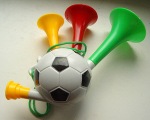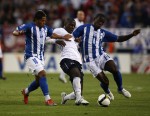In 2009 I attended both a Gold Cup semi-final and a Word Cup qualifier. In both matches: USA vs Honduras.
Both times the happy Honduran fans brought both the noise and the numbers. The sea of blue and white was impressive, and the first I’d ever heard of a “Vuvuzela” was at those games but it was called “corneta” by the Latin Americans. I still didn’t know then that I would one day learn the word “Vuvuzela.”
All game it was an atmosphere of Carnivale. Singing, cheering, drinking, and Spanish were heard all around me not to mention the cornetas. Below me one row was Alex, a Honduran fan who coupled his trip to America with soccer and family, and beside me some American Fans. All game I talked with Alex about Honduras, and he was excited to speak English. He did have to dig some for full sentences, but I knew what he wanted to say and lots of hi-fives and shared soccer moments later he was like a new one-off friend.
The last 15 minutes of the match were intense. Honduras were playing well, but the US were ahead 2-1 and their side just was not cutting it. It would seem our foreign visitors and their local counter-parts had lost their national vigor and accepted the loss as a personal one. Which made leaving the stadium bitter-sweet.
While the US had won the match on home ground, it would seem Honduras were truly the home team and they had lost at home.
Q: When did you find out that the ‘soccer horns’ were in fact Vuvuzelas?
A: While watching the confederations cup in 2009 the Vuvuzelas were more rampant than I or anyone had ever heard them and were becoming a concern for both broadcasters and players on the field. The Vuvuzela not only became a popular talking point but a heated one as FIFA would have to decide between allowing or disallowing the soccer horns into world cup stadiums.Q: What more can you tell us about the Vuvuzela?
A: Traditionally made and inspired from a kudu horn, the vuvuzela was used to summon distant villagers to attend community gatherings; much like a . . Anyone? Can anyone guess . . . ? A Shofar. A Vuvuzela is essentially a Shofar and vice-versa.Q: Do you find that to be a strange coincidence?
A: Not really, but damn those things are loud.

